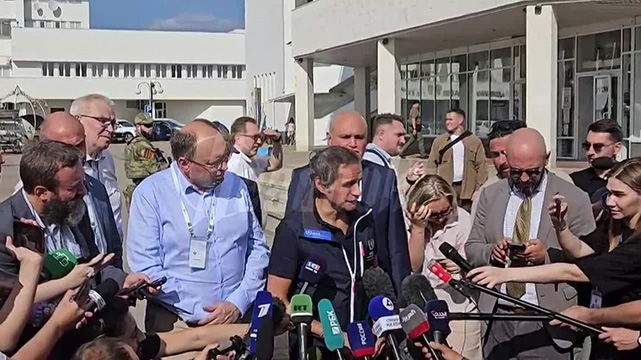 Rafael Grossi with journalists at Kursk Nuclear Power Plant
Rafael Grossi with journalists at Kursk Nuclear Power Plant
Photo from TV screen
The visit of International Atomic Energy Agency (IAEA) Director General Rafael Grossi is due to the proximity of hostilities and the danger of a nuclear incident. Rafael Grossi announced to journalists on Tuesday that during his inspection of the Kursk Nuclear Power Plant (NPP) in Russia he personally saw traces left by drone attacks on the plant’s territory, TASS informs.
Grossi said he had been previously briefed about several cases of drone attacks on the Kursk NPP and being at the plant today he saw for himself the signs left by the mentioned-above attacks.
"There have been activities near here, I was informed about the impact of drones and was shown some remnants of drones and signs of the impact they had," the IAEA chief told journalists.
Earlier, said that the risk of any damage to the nuclear facility due to actions by Ukrainian troops was great. He informed of his plans to visit the power plant in order to talk to its leadership and determine whether any attacks had been carried out against it.
Grossi told reporters that he had decided to visit the city of Kurchatov and the Kursk nuclear power plant because fighting is taking place nearby, thus creating "a danger of a nuclear incident" there.
Grossi also commented on the comparison between the Chernobyl and Kursk nuclear power plants. "First of all, equating the Chernobyl [NPP] with the Kursk [NPP] is an exaggeration. But this is the same type of reactor, it has no specific protection. And this is very very important. If there is an impact on the materials there, the consequences will be very serious," he emphasized. At the same time, it is difficult to say whether it will be on the same scale as the Chernobyl incident, he added.
The IAEA stated that military actions near the NPP represent a serious risk to its nuclear and physical safety and security. A visit to the Kursk NPP was a timely opportunity for an independent assessment of the situation, according to the IAEA’s press office.
Grossi has inspected both the Kursk nuclear facility and the Kursk NPP-2 plant that is currently under a construction. Later in the day, he visited social facilities in the town of Kurchatov.
The Kursk NPP is one of the four biggest power plants in Russia and is a major node of the country’s unified energy system. Kursk NPP-2 is being built to replace the retiring power units of the existing plant.
The commissioning of the first two power units of Kursk NPP-2 is planned to be synchronized with the decommissioning of the first and second power units of the operating plant.
The Ukrainian military launched a massive attack on the borderline Kursk Region on August 6. A missile danger has been repeatedly declared on the territory of the Kursk Region.
The International Atomic Energy Agency (IAEA) has been shown the results of the Ukrainian military’s attacks on the Kursk nuclear power plant and there can be no ambiguity as to who carried out these strikes, the CEO of the state nuclear power corporation Rosatom, Alexey Likhachev, has told the media.
"The results of concrete attacks have been presented, and there can be no ambiguity as to who carried out these strikes, where they came from, in this case," he said.
Likhachev noted that the IAEA "lives by its own rules, its own norms" and does not always say what Russia rightly expects to hear, so there is no option left other than "to work patiently and to continue to present more arguments."
Earlier, law enforcement agencies told TASS that on the night of August 22, the Kiev regime attempted a kamikaze drone attack on the nuclear power plant in Kurchatov. The drone was shot down and found near the spent nuclear fuel storage facility. Russian Foreign Ministry Spokeswoman Maria Zakharova called the Kiev regime's attempt to attack the nuclear power plant an act of nuclear terrorism that required an immediate response from the IAEA.
The Kursk NPP is one of Russia's four largest nuclear power plants of the same capacity. Located near the city of Kurchatov, it is the main node of the country's unified energy system.
read more in our Telegram-channel https://t.me/The_International_Affairs

 11:21 28.08.2024 •
11:21 28.08.2024 •






















